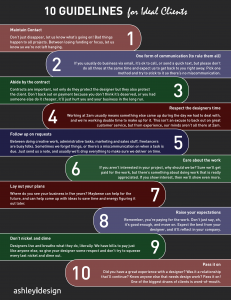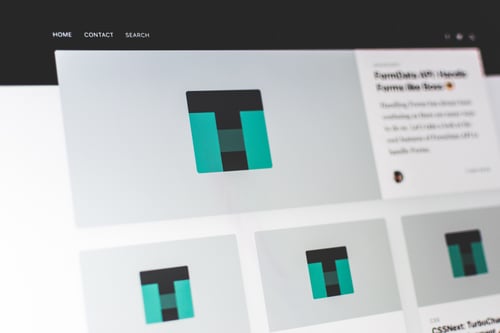
10 Guidelines for the Ideal Client
Over the years I’ve had the pleasure, and sometimes displeasure, of working on projects with varying degrees of success. By success I’m talking about a smooth relationship with my client, one where communication and setting expectations is the priority. I’m thankful to have that kind of relationship with all my clients now, but it wasn’t always that way.
Though I came up with the following guidelines years ago during my first stint as a full-time freelancer, they are still relevant today. I have gone through and updated the descriptions, however. And, at the bottom of this post is an infographic of the guidelines you can share with others.
Maintain Contact
One of the things designers hate is when a client disappears. Either before, during or after a job, we want to know how things are going, what the results of our work were and what we can do to improve ourselves. If you're in the middle of a project and just stop communication, it could mean a multitude of things to a designer. Either you don't care about the project, you don't respect the designer or you've found someone else. While these things are sometimes unavoidable, don't just disappear, let us know what's going on! Bad things happen to every project, and whether it's losing funding or focus, let us know so we're not left hanging.
One form of communication (to rule them all)
I had a client that would email me, text me and call me, all within the hour. Though we'll work with the client to manage the best form of communication, it can be difficult to manage conversations on different platforms. If you usually do business via email, it's ok to call, or send a quick text, but please don't do all three at the same time and expect us to get back to you right away. Pick one method and try to stick to it so there's no miscommunication.
Abide by the contract
This can be one of the worst offenses, because it usually means having to threaten legal action, and that’s never fun. If you've signed a contract with the designer, and decide not to pay, or otherwise break that contract, then be prepared to hear from a lawyer. Contracts are important, not only do they protect the designer but they also protect the client. Don't back out on payment because you don't think it's deserved, or you had someone else do it cheaper, it'll just hurt you and your business in the long run. With that said, designers have to abide by a contract as well, and the same rules apply.
Respect the designers time
Just because we're up at 2am finishing up a project doesn't always mean we'll be able to answer your email right away. Working at 2am usually means something else came up during the day we had to deal with, and we're working double time to make up for it. This isn't an excuse to back out on great customer service, but from experience, our minds aren't all there at 2am. The same thing applies to vacations. As a freelancer, I take time off when I can get it, and if you've been informed the designer will be out for a few days, please respect that.
Follow up on requests
Between doing creative work, administrative tasks, marketing and sales stuff, freelancers are busy folks. Sometimes we forget things, or there’s a miscommunication on when a task is due. Just send us a note, and usually we’ll drop everything to make sure we deliver on time.
Care about the work
If you aren't interested in your project, why should we be? Sure we'll get paid for the work, but there's something about doing work that is really appreciated. If you show interest, then we'll show even more. A lack of care for the work reflects in more than just your communication, and it's in your best interest to show some respect for your field; your customers will see that.
Lay out your plans
You want a logo now, and maybe a website, you've said. Where do you see your business in five years? Believe it or not, but I care about my clients, and how well they succeed. What's your business model? Maybe we can help for the future, and can help come up with ideas to save time and energy figuring it out later.
Raise your expectations
Remember, you're paying for the work. Don't just say, oh, it's good enough, and move on. Expect the best from your designer, and it'll reflect in your company. Just like caring about the project, not expecting poor quality design means you want it to succeed, and will push us that much more to make something spectacular.
Don't nickel and dime
There's ads all over the place looking for 'rockstar' designers, promising the best internship ever...for no pay. With design, you get what you pay for. A $500 website is not going to be anything like a $2500 one, it's just not possible. Designers live and breathe what they do, literally. We have bills to pay just like anyone else, so give your designer some respect and don't try to squeeze every last nickel and dime out.
Pass it on
Did you have a great experience with a designer? Was it a relationship that'll continue? Know anyone else that needs design work? Pass it on! One of the biggest draws of clients is word-of-mouth. It can be one thing to see a designers portfolio and think it'll be a great experience, and another to hear directly from someone that hired them. Plus, most designers have a way of rewarding clients that pass on their info to other future clients, whether it be some free marketing material to a percentage off the bill. Keep your designer in mind!
Your Turn
Have any additions for this list? Think something shouldn't be on here? Let me know!
If you found this article helpful, please share it with others using the image below:
I help businesses and marketers build marketing and sales systems that drive leads and scale with ease.
Not sure where to start? Take my marketing quiz and get personalized next steps.




